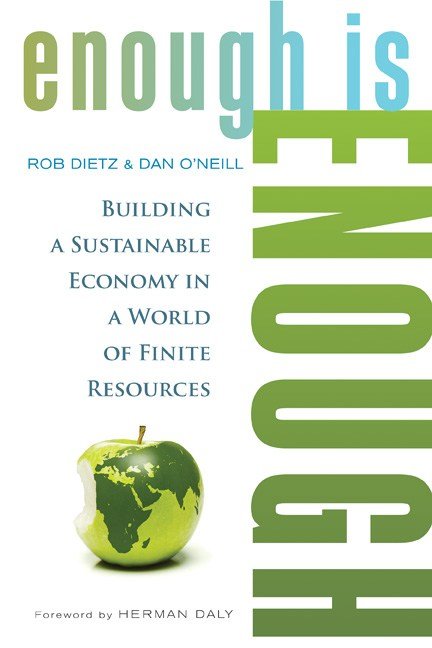Enough Is Enough
by Brian Czech
I have a running dialogue with my steady-state friends and colleagues. The subject is best described with the metaphor of a horse and cart. I say, if we want to succeed in replacing the outdated goal of economic growth with a steady state economy, we have to put the horse before the cart. The horse is the public opinion and political will needed for this change. Without this horse, I say, we have little hope of pulling a cart of steady-state policies into the economic policy arena.
Many of my friends and colleagues, however, say otherwise. They say I have it backwards. Citizens won’t be ready, they say, to support steady-state policies unless it is clear in advance just what those policies are.
Sometimes I think my friends and colleagues are right. Certainly one of the most common questions I get, after pontificating on the perils of growth and the need for steady-state economics, is “Yes, but how do we do it?” When I describe the horse and cart, emphasizing the horse, some of the audience don’t buy it. They want to know more about the cart before offering their horsepower.
I suppose we are all onto something. The horse and the cart may have to materialize more or less in tandem. Otherwise the horse may say “that’s enough of this” and walk away, as the grass may seem greener in more conventional “sustainability” pastures. On the other hand, even the sturdiest cart of steady-state policies would mire down and rust without the horse of public opinion and political will to lead it into action.
So it was mentally agonizing for me to miss the first ever Steady State Economy Conference, especially with CASSE as co-organizer with our partner, Economic Justice for All. I went instead to a different conference (Association for Environmental Studies and Sciences) in Portland, Oregon, where many new recruits to the steady-state cause were assembled. Meanwhile, the steady-state conferees in Leeds, UK were busy constructing and filling a cart full of steady-state policies. Theirs was an exciting undertaking. My belated contribution is to wholeheartedly endorse the report of their conference!
Actually the report, aptly titled Enough is Enough, provides more than just a cart of public policies for achieving a steady state economy. Part One is mostly about the horse, describing why economic growth has become uneconomic — dangerously so — and describing the alternative: economic degrowth toward a steady state economy. However, the bulk of Enough is Enough is found in Part Two, which is all about the cart of policies. This constitutes the single most complete collection of steady state policy initiatives, tools, and reforms in the literature. That alone makes the report worth its weight in steady-state gold. As if that were not enough, Part Three puts it all together into a plan to get the horse and cart moving together to begin the economic transition.
Enough is Enough is an extremely interesting and unique document. It is academic and book-like in length and style, and as well-documented as a Jared Diamond bestseller. Yet it also puts the reader into the venue of a wonderfully orchestrated, interactive, and productive conference. One can almost hear the plenary talks from the podium in Part One, walk the halls to the diverse workshop sessions in Part Two, and reconvene with the conferees in Part Three.
Most conference proceedings, book-like or not, go quickly onto a dusty shelf. I doubt this is the fate of Enough is Enough. For one thing, the university instructor may easily construct a summary slideshow from the plethora of colorful figures, tables, and graphs. Some of the graphics will be familiar to students and practitioners of ecological economics; others were developed at the conference or in the aftermath of this creative burst of energy. Beyond its academic uses, Enough is Enough has the potential to become a manifesto in the hands of policy reformers working on issues of environmental protection, economic sustainability, and social justice.
But most importantly, in my opinion, is that steady statesmen and ambassadors, present and future, won’t miss a beat when confronted with the challenging question of “Yes, but how do we do it?” With a sturdy cart of policies hitched to a horse of public opinion that grows stronger by the day, we are ready to set out towards the steady state economy.
Click here to download a free copy of the full report (130 pages).



Brian: Again, your writing and the report reflect most of my own biases. As you may remember from our previous correspondences and phone conversation in past years, I heartily support the core concepts you espouse, and the fact that you have enough colleagues to get a meeting together indicates that it is an idea for these times.
The report summary calls for debate. I wonder, though, if this statement is truly serious, or whether an impenetrable paradigm has hardened around the concept. I have a number of fundamental concerns, but please understand that I, too, have worked very hard in this realm, and do not want to merely rant about them. I am willing to engage with those willing to engage with me, all the way to a reasoned conclusion. I have nothing against opinions and good “editorial” writing, but I am proposing something quite different; whether or not this is the right place for it is, I suppose, “debatable.” Nor is “comment” the right word . . .
When we spoke a few years ago I declined to become a member of an organization, largely because I take such responsibility so seriously that I felt that I could not participate fully. I still feel the same way, and time has not improved my energy any more than the disintegrating economy has boosted my already scant retirement fund. But if you and your colleagues do intend to carry on a discussion of how to proceed along the lines of this report, I will do my best to hang in there until a reasoned conclusion is reached—or as long as I last.
You may remember that I was at work on two related projects entitled “Advancing Toward Eden” and “Culture Against Society.” These titles should give you a hint of their relevance to the “Steady-State Economy” and of my basic concerns. I have forgotten to what length we discussed them a few years ago. I have posted this here because the last time I sent you an email you asked me to post to this blog. I hope I have not made a mistake by submitting it here; if so, please feel free to decline to post it and accept it as a private communication.
I am concerned that there seems to be so little action on this blog, so I wonder if the discussion for which the summary calls takes place elsewhere . . .
I wish that Brian and Herman and others concerned about growth would read Richard Heinberg’s
recent essay declaring that the age of growth is now over as published at http://www.postcarbon.org and http://www.energybulletin.net. Heinberg pointed out that with the passing of Hubbert’s Peak of worldwide petroleum production, it will no longer be possible for the world to sustain growth over the long term, though local or short-term growth will be the misguided policy of the financial and economics community until reality persuades otherwise.
I would urge Brian Czech and Herman Daly and other steady-staters to focus, not so much on a steady state economy, but on an equitable economy with fair access to resources, fair government policies on taxation and distribution of wealth, etc. This needs to be now, while energy is still available at similar scales to historic ones, because we will be soon entering a worldwide zero sum competition for petroleum and other resources, and already we are seeing resource wars in Iraq and Afghanistan and threats of resource wars in Iran and elsewhere. The entire world economic and financial systems as well as commerce in general are built on a growth paradigm that is quickly becoming obsolete.
Wake up Brian! Don’t worry about that horse and cart and shift your vision to the fact that a new paradigm is quickly emerging and the struggle for growth will be an obscenity that puts the poor and quickly disappearing middle class of America at a struggle the likes of which have never been seen in the US. This is the stuff of revolution and international war.
Stan Moore
San Geronimo, CA
Stan,
It would seem to me that the economy you talk about, one “with fair access to resources, fair government policies on taxation and distribution of wealth, etc” is a steady state economy. What we ultimately call the new paradigm when the chips fall is a somewhat moot point – so long as the polices you state happen. In order for all those things to happen, we must also recognize growth as not the goal of the economy.
I believe Herman Daly has said it before, that we can choose this course or it will be chosen for us. So weather you term it a steady state economy or the end of the current paradigm, if we want to maintain a civil society and achieve those goals we will be turning away from the growth economy towards an equitable, sustainably scaled economy. The rest is semantics, in my mind.
Cheers,
Joshua
I was glad to skim through the report and find its range of concepts, and refreshed especially to see the number of references to employee ownership, co-operatives, and community-interest companies. Stan Moore´s enthusiasm for this side of the approach is one I certainly share. However, another level of approach I would keep closely intertwined is the cradle-to-cradle approach of McDonagh and Braungart´s certification, along with a catalogue of existing strategies.
William Greider has described employee-ownership and whole cost accounting in a profound and engaging way in his 2003 book, The Soul of Capitalism, and deals with such intriguing examples as Solidarity, a temp company in Baltimore developed from a support group/ 12-step recovery community and Blue Ridge Paper, which also pursued environmentally responsible and essentially clean effluents. The range of stories and existing efforts from Ecover Detergent´s open source availability to Interface Carpet´s extreme commitments and financial savings, to Greenpeace´s “Greenfreeze” technology developed first through a struggling East German manufacturer and now open sourced are only small tidbits. The appearance of co-operatives in such areas as food purchasing and renewable energy development are another sampling, with existing examples in such places as the state of Ohio.
At the policy level, we have such interesting examples as the international level of the Aarhus Convention on Access to Information, Public Participation, and Access to Justice in Environmental Matters and the range of environmental centers established. The role citizens alone can have is reflected in many efforts by NGOs, though one of my favorites is the Brent Spar episode in which Greenpeace and the group´s supporters engaged in their full repertoire of activities to communicate with up to government officials about the hazards of oil rig dumping and the benefits of recycling. Loefstedt and Ortwin give a great accounting in their Risk Analysis article of 1997.
In our reflections and our reports, I encourage the practice of linking theory and practice to avoid the trap of abstraction and reification. Without vivid references to ongoing successes in practice, many people will not find it so easy to bridge from their current habitual modus operandi´s, I think. While the Danish Wind Turbine Owner´s Association had great pluck in 1980 or so, the US Food Co-ops around the same time, and Fair Trade currently, not everyone finds themselves with those same vivid imaginations ready to act unless specific groups and efforts are referred to vividly. For that matter, I am reminded that Amitai Etzioni the longtime sociologist, wrote a 2004 article on Voluntary Simplicity, and Philip McMichael has referred to Slow Food consistently in his writings on the global food system. Now those are cultural practices that are gaining some steam, so to speak.
Nevertheless, thanks for the inspired policy talk, and great job in that realm!
I agree fully with the principle point of this article.
I use a slightly different language :
That to begin and maintain great popular movements it is the moral sense rather than the intellect that must be appealed to. Sympathy rather that self-interest.
And see the same road blocks within the reform movements.
We tend to lead on policy and winners. Intellect and the pocket. The cart. Before we are all agreed and united about the great wrong in principle.
And unless that question can clearly define right from wrong, it will never muster a force with enough power to provoke a widespread discussion nor excite large numbers to action.
So the most perfect policies will remain gathering dust.
Yes, both must be done in harmony. But today what is the balance? It seems that is about 90%/10% to the practical politics and the principle respectively. I’m calling for them to be at least 50/50.
Real Reform: An innovative strategy for reform? Appeal to the moral sense first, the practical politics later.
Yours,
Robin Smith
Real Reform
– Restoring natural economics
– Politics for the 21st Century
– A future for our descendants
That is a pretty apt analogue with the cart, all too often the greener pasture does seem to play a role when it is a matter of public opinion. People seem to forget very quickly and instead simply want that quick fix or promise.
The real measure of your wealth is how much you’d be worth if you lost all your money.